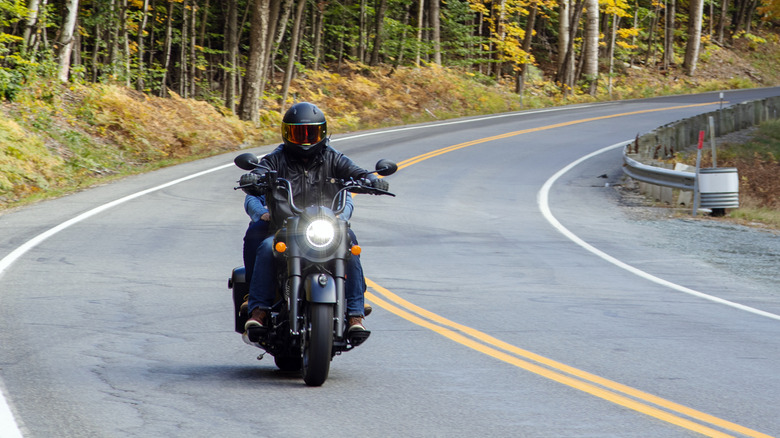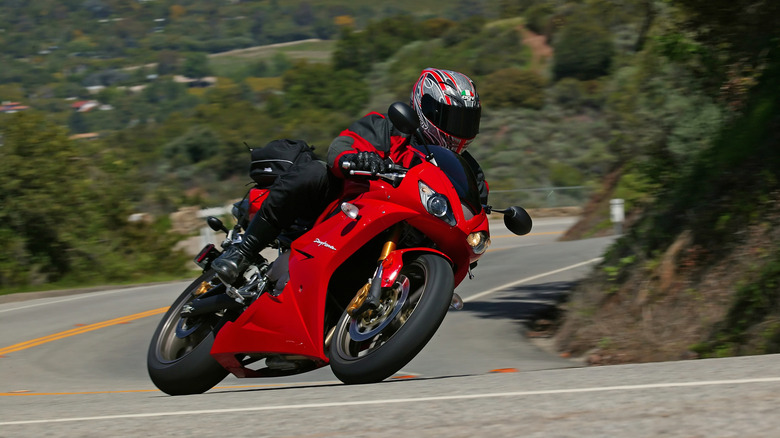How Far Can A Motorcycle Lean? Speed Is An Important Factor
We may receive a commission on purchases made from links.
With over 8.8 million registered units in 2023 for the United States alone, motorcycles are one of the most popular forms of transport. A key reason for its appeal is the many types of motorcycles available for beginners and seasoned riders alike. Compared to larger vehicles like cars, motorcycles are extremely maneuverable and nimble machines, due to being lighter, and easier to steer. Together with steering, a basic maneuvering and turning technique for motorcycles is leaning, which allows the bike to maneuver and remain balanced while turning. The maximum lean angle for a motorcycle can be found in MotoGP racing, where the riders can achieve 65 degrees, but for normal motorcycle riding, the maximum is 20 degrees.
A motorcycle's lean angle is the amount of tilt it makes when negotiating a bend. Tire grip, rider technique, speed, and the geometry of the bike affect the maximum lean angle of a motorcycle, and this is why high-speed motorcycles like those in MotoGP can lean a lot more. For motorcycle riding, leaning is useful and needed, especially when negotiating corners, because an upright bike will keep going straight, making it impossible to turn a motorcycle without leaning.
The lean angle of a motorcycle is greatly affected by its speed. The key reason for this is that the centrifugal force rises when speed is increased while the turn radius remains constant; as a result, the lean angle must also be increased to offset it. If the lean angle is not adjusted, the turning radius gets bigger, and the motorcycle will start to travel wide, which may cause loss of momentum and increase the risk of crashes due to leaving corners slowly.
Using the correct technique
For normal riding, the 20-degree lean angle limit was analyzed by the German writer, scientist, and psychologist Bernt Spiegel in his book The Upper Half of the Motorcycle. Spiegel described humans' innate sense of security, where a rider can only comfortably lean roughly 20 degrees when running at full speed and not slipping, and by going beyond that, a panic reaction is triggered because of survival instincts. To go beyond 20 degrees, developed riding skills are required, while for more extreme lean angles like in MotoGP, it will require a combination of the skill set and techniques of an experienced racer to control the bike and avoid crashing alongside the advanced design and specialized tires of a MotoGP motorcycle.
The importance of learning how to lean a motorcycle begins with maintaining stability, by allowing the rider can steer the bike and keep it from toppling over. Next, a rider can change direction more efficiently by leaning and also apply counter-steering by combining the rider's weight and the bike's lean, allowing steering with less effort. Lastly, a rider can quickly adapt to unforeseen obstructions or changes in the road surface by leaning.
Due to the inherent risks of riding, motorcyclists are vulnerable to traffic-related accidents, making motorcycle riding safety essential. Together with wearing safety gear and regular bike maintenance, it is important for riders to know the capabilities and limitations of their motorcycle. Additionally, motorcycle owners must learn to use correct riding techniques, including how to lean, to further develop their riding skills and avoid mistakes when using a motorcycle. Riding motorcycles can be made better by consistently following best practices, to ensure risks are mitigated and make riding safer and more enjoyable.

